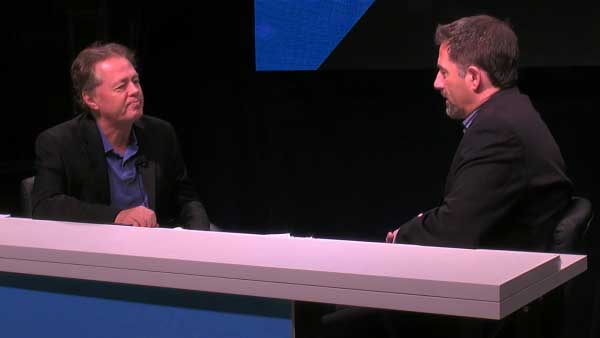Warehouse Education and Research Council 2016
Two weeks ago was a crazy time for supply chain related conferences. I was at the Gartner Supply Chain Executive Conference in Phoenix for two days (see Trip Report: Gartner 2016 Supply Chain Executive Conference), but before that had time to spend just one day at the Warehouse Education and Research Council (WERC) 2016 conference in Providence, RI of all places, enough that I can squeeze a trip report out of it, which you will find below.
I will just note that also that same week was the Institute for Supply Management's large annual conference, user group events for Manhattan Associates and SAP, and a couple of other supply chain events as well. Unfortunately, I can only be in one place at a time, and placed my bets with WERC and Gartner.
| GILMORE SAYS: |
"Picking to a cart - common in ecommerce fulfillment and beyond - could utilize a visual map of what products at a given location are required in what quantities across the cart bins.
WHAT DO YOU SAY?
Send us your
Feedback here
|
As I have written in the past, the WERC event is a low key kind of affair, in a positive way, with a relaxed vibe that offers a pleasant overall experience. There are many supply chain and logistics practitioners who are very loyal to the organization. About 1000 of them again showed up in Providence, featuring presentations across some 15 tracks, which again this year featured a group of sessions focused on retail and healthcare supply chains, added I believe in 2014.
Here's what I saw:
Sven Verstrepen, now with Belgian logistics services provider Ahlers, was back for second straight year leading a presentation on so-called "horizontal collaboration."
What does that mean? As contrasted with vertical collaboration between trading partners such as suppliers or customers, horizontal collaboration involves arrangements with peer companies - sometimes even a company's own competitors.
More specifically, it really focuses on logistics collaboration, sharing warehouse and especially transportation resources across two or more shippers. It is very hot right now in Europe, though slow to gain much hold in the US, as I will discuss in a moment.
There are six or seven versions of horizontal collaboration, including one you could call "co-mingled freight," in which shippers of heavy goods marry trailer or container loading with companies that ship light products, in a way that improves total trailer efficiency.
Then there are "round trips," a practice sometime seen in the US in which companies with complementary routes in each direction use a single truck; mode shifting, in which combining freight can sometimes lead to more efficient transportation mode selection, with a difference in Europe in that it can sometimes lead to a move to all water transport; sharing DC capacity and then mixed loads to retailers, etc.
There is a well-publicized case study in Europe involving Procter & Gamble and Tupperware that involved two of these practices, starting with co-mingling heavy and light freight that not only allowed more complete trailer utilization but enabled Tupperware to also utilize intermodal transport instead of truck, as P&G had been doing. The program reduced combined logistics costs 17% and CO2 emissions 30%.
And that last point is important, because it is in fact reduction in CO2 emissions that are driving much if not most of the collaboration activity in Europe, more so than the savings. Last year, Verstrepen cited an example of a collaboration that produced no cost reductions but was pursued anyway just for sustainability improvements.
So, a bit less CO2 fervor here is one reason that the US is well behind Europe in horizontal collaboration. Another is that it's just often seen as too hard versus other alternatives, according to co-presenter Geoffrey Milson of consulting firm enVista. He noted that while often savings of 7-15% are possible, the effort in terms of process changes, IT integration and more often just looks too daunting versus other transportation strategies that might also deliver savings.
So, will that situation ever change? Verstrepen noted the active role government has played in Europe to drive this evolution, including a program in the Netherlands called "Synchromodal Transport" in which the government there is actually providing the platform for finding and managing these collaborations.
Would that fly here? I doubt it - but I think this will in fact come to the US nevertheless, with profound implications for the practice of logistics management across many dimensions, including a new class of 3PLs to manage all this.
I also saw in interesting presentation from George Bowser and Saman Saiy of DHL supply chain (formerly Exel Logistics) on use of "augmented reality" in distribution centers, specifically the use of "smart glasses" in order picking applications.
DHL has been doing a lot of research on this topic. The concept of augmented reality means adding something digital (text, graphics, video) to what a person such as DC worker sees.
While others have been doing work in which the associate actually identifies the product to be picked using the glasses through imaging technology, DHL has settled on using a finger-mounted blue tooth ring scanner for product identification connected to the glasses.
The augmented reality can come in through several ways. Imagine that when a picker is moving down an aisle on a pallet jack that the location for the pick is "lit up" in some way through the glasses, so the picker can see exactly where the next stop is and can manage speed of the vehicle according.
Pickers on foot or on a vehicle could have optimal pick path similarly visualized, and perhaps most interestingly, picking to a cart - common in ecommerce fulfillment and beyond - could utilize a visual map of what products at a given location are required in what quantities across the cart bins. So, it is in a sense like pick to light from a worker's perspective, without the need for the physical lights themselves.
Interestingly, in DHL's work the orders for a batch or wave are sent to the glasses at the start of the work, not dynamically for each pick. This, I was told, was to ensure no delays in processing from pick to pick, especially necessary if say the glasses were to show an image of the product to be selected.
But isn't that taking us back in effect to the old batch data collection approach, before that was utterly eliminated in favor of real-time RF? I need more insight here. Relatedly, one attendee obviously with some experience said from what he has seen the issues are what happens when something goes wrong, such as a worker realizes he/she made a mistake after confirming a pick.
Regardless, it was interesting, with a lot more to come for sure. DHL did a three-week pilot with Ricoh in Europe that demonstrated 25% picking improvement versus RF (though I believe the comparison should really be to voice and/or "smart carts"). DHL is investing heavily in this, and it has several other pilots going across the globe, also seeing augmented reality applications in areas such as maintenance, value-added services and more beyond picking.
In the first session of the day on Monday, I saw an interesting discuss of transportation procurement from Ryan Focke of Kroger and Kevin Zweier of consulting firm Chainalytics. It was a wide ranging discussion that covered a lot of ground and is not easy to summarize, but here are a few highlights.
As most know but good to hear again, a shipper can always find lower rates, but that does not necessarily mean lower costs. There are many soft costs relative to service levels, administrative overhead, damage, etc. that need to be measured and considered.
A transportation procurement "event" is at least as much a relationship management process as it is a rate pricing exercise, because of course the volumes are not legally binding on either side. But the only way to be pretty confident you are getting excellent rates is to constantly be "in the market" for at least some of your freight.
Data is the Achilles' heel of transportation procurement processes, both in its accuracy and its timeliness/latency. Transportation procurement tools can't help you here, but the result hugely depends on getting the data right.
Doing procurement on a global basis is especially tough. Data of course can be really bad, you have to deal with currency issues, often no standard definitions of capacity, regulations change frequently, etc. But some companies are trying this on a more centralized basis.
I am out of space, but highly recommend you take a look at the YouTube channel of motivational speaker Destin Sandlin. You will learn a lot about how the physical world really works, including why in fact cats can usually land on their feet. Good stuff.
Good day a WERC 2016. Wish I could have spent one more there.
Do you see horizontal collaboration gaining hold soon in the US? Are you bullish on augmented reality or not? What did you think of WERC 2016? Let us know your thoughts at the Feedback section below.
|












